Nionicotinoids Kill Bee
EPA Releases Study on Pesticides Killing Bees, Gets Sued Immediately by Beekeepers
A new study by the Environmental Protection Agency has found evidence through a study that backs what activists and environmentalists have asserted for years: one of the most widely used neonicotinoid pesticides can, indeed, cause declines in honeybee populations. But the agency’s findings are too little, too late for many farmers and food safety advocates, who consider the EPA neglectfully responsible for widespread employment of neonicotinoids.
Driving the urgency of the point even further, researchers with Sussex University discovered something far more alarming: wildflowers growing near neonicotinoid-treated crops play host to a “chemical cocktail” which has an impact on bees 1,000 times more potent than previously believed.
EPA researchers focused only on imidacloprid, one of several varieties of neonics, which together have become some of the world’s most widely used insecticides — with the exception of the E.U., where it has been banned for use — since coming to market in 1994. Evidencing the push for quick and facile solutions, and the quest for profit over safety, neonics have not been tightly regulated in the United States.
Beekeepers and food safety advocates, concerned for years about neonics’ likely role in hive decline — as well as the decline in other pollinator populations, such as monarch butterflies — finally initiated a lawsuit on Wednesday against the EPA.
“Center for Food Safety, on behalf of several beekeepers, farmers and sustainable agriculture and conservation groups, filed a lawsuit [on January 6] challenging the Environmental Protection Agency’s (EPA) inadequate regulation of the neonicotinoid insecticide seed coatings used on dozens of crops,” the Center for Food Safety stated in a press release. “EPA has allowed millions of pounds of coated seeds to be planted annually on more than 150 million acres nationwide. The lawsuit alleges the agency has illegally allowed this to occur, without requiring the coated seeds to be registered under the Federal Insecticide, Fungicide, and Rodenticide Act (FIFRA), without enforceable labels on the seed bags, and without adequate assessment of the serious ongoing environmental harm.”
Neonicotinoids are favored by many farmers for their ease of application and relative low maintenance, as they’re considered ‘systemic’ insecticides; and due to their water-solubility, plants easily transport the insect toxin to all tissues — leaves, flowers, roots and stems, as well as pollen and nectar. Neonic-laden products are applied to the plant’s roots by either drenching the soil or soaking the seeds, then the neonic persists in the plant as it matures.
But for farmers who grow corn, avoiding neonicotinoid-treated seeds is virtually impossible. In a May 2012 press release — and keeping in mind employment of neonics grows almost exponentially each year — the Pesticide Action Network explained:
At least 94% of the nation’s 92 million acres of corn will be treated with one of two neonicotinoids, both manufactured by Bayer, [covering an area] greater than the total size of the state of Minnesota, Nebraska, or the Dakotas (combined). In addition, these are among the largest honey producing states in the country, housing some of the nation’s largest pollination services businesses. On average, USDA reports that beekeepers have been losing over 30% of their honey bee colonies each year since 2006.
Even more perilously, up to 95% of neonics applied to the seed coating actually winds up contaminating the air, soil, and water, rather than the plant for which the insecticide was intended.
“My honey farm business is not capable of surviving another three to five years if EPA chooses to ‘drag out’ the treated article exemption in the courts at the request of the pesticide industry instead of properly regulating these pesticides. People need pollinated food; somebody must stand up and say no to unregulated killing of pollinators,” said lead plaintiff in the lawsuit and beekeeper, Jeff Anderson.
 “A single seed coated with a neonicotinoid insecticide is enough to kill a songbird,” warned Cynthia Palmer, director of pesticides science and regulation at American Bird Conservancy. “American Bird Conservancy urges the agency to evaluate the risks to birds, bees, butterflies, and other wildlife.”
“A single seed coated with a neonicotinoid insecticide is enough to kill a songbird,” warned Cynthia Palmer, director of pesticides science and regulation at American Bird Conservancy. “American Bird Conservancy urges the agency to evaluate the risks to birds, bees, butterflies, and other wildlife.”
Tragically, the EPA continues to allow systemic seed-coating insecticides onto the market, with several currently “poised” for approval.
“EPA can’t bury its head in the sand any longer,” asserted Marcia Ishii-Eiteman, senior scientist at Pesticide Action Network in support of the lawsuit. “Seed coatings are just the latest delivery device of pesticide corporations that pose a threat to pollinators and the food system.”
This article (New Article Template) is free and open source. You have permission to republish this article under a Creative Commons license with attribution to Claire Bernish and theAntiMedia.org. Anti-Media Radio airs weeknights at 11pm Eastern/8pm Pacific. If you spot a typo, email edits@theantimedia.org.
http://www.naturalblaze.com/2016/01/epa-releases-study-on-pesticide...
"Destroying the New World Order"
THANK YOU FOR SUPPORTING THE SITE!
Latest Activity
- Top News
- ·
- Everything
THE GREAT FLOOD Official Trailer (2026) Netflix | Global Disaster Movies 4K
Mothman Prophecies
The 100 Series Designated for SAC and a Possible WWIII
Human Be-In - Full Program - 1/14/1967 - Polo Fields, Golden Gate Park (Official)
Sebastion Piñera and 5G
© 2025 Created by truth.
Powered by
![]()

You need to be a member of 12160 Social Network to add comments!
Join 12160 Social Network